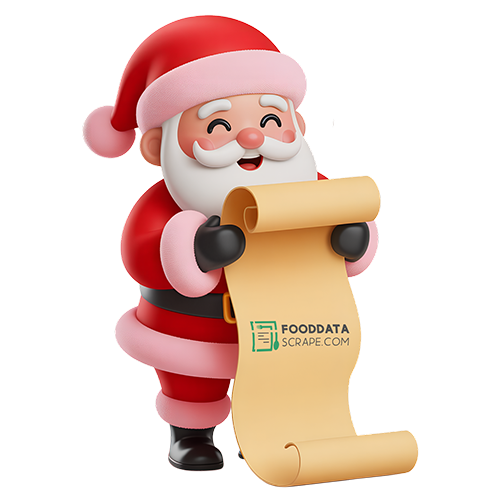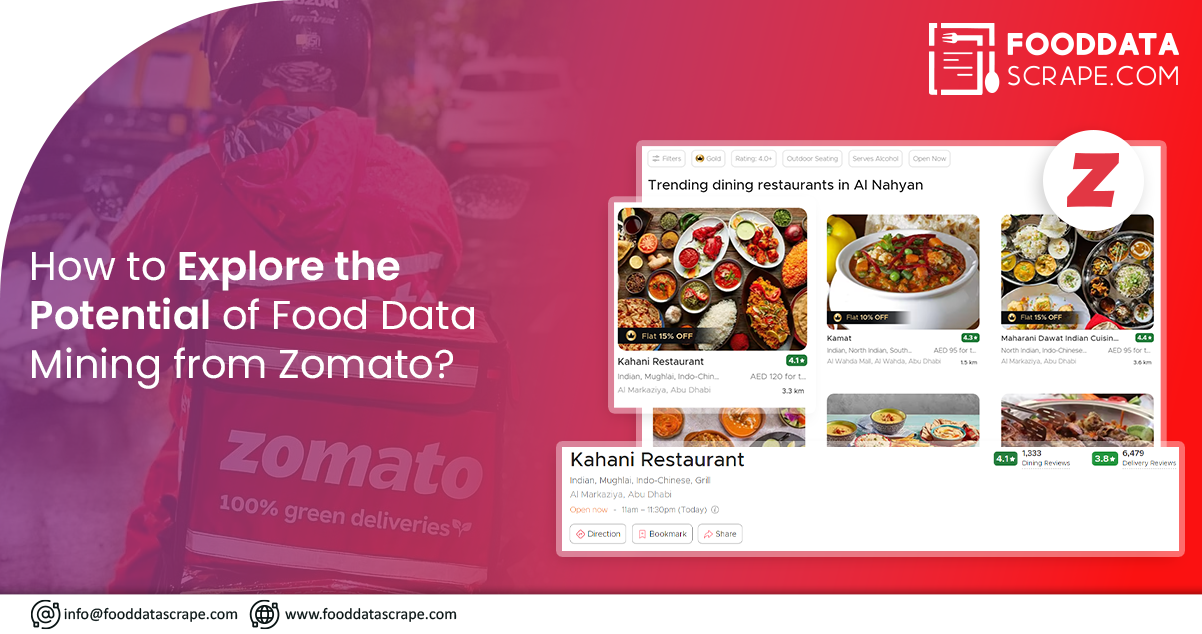In the era of data-driven decision-making, the food industry is no exception. From restaurants looking to optimize their menus to food enthusiasts seeking the next culinary adventure, data plays a crucial role in shaping experiences and choices. One of the most comprehensive sources of food-related data is Zomato, a global restaurant discovery and food delivery platform. In this article, we will explore the fascinating world of food data mining from Zomato, focusing on extracting menu items along with price details for a specified list of 100 restaurants.
Zomato: The Goldmine of Data
Zomato, founded in 2008, has evolved into a powerhouse of restaurant information, reviews, and food-related data. With a presence in over 24 countries, it boasts a vast database of restaurants, menus, user reviews, and ratings. Zomato's extensive coverage of worldwide eateries makes it an ideal playground for food data enthusiasts and businesses. Scrape Zomato food delivery data to unlock a treasure trove of culinary information and insights, empowering your business decisions, culinary research, and gastronomic adventures.
The Need for Food Data Mining
Imagine you're a restaurant owner looking to revamp your menu. You want to analyze your competitors' offerings, identify trends in pricing, and understand which dishes garner the most attention. Alternatively, you might be a food blogger or researcher interested in studying the popularity of specific cuisines or the impact of pricing on restaurant ratings. You need access to a large-scale dataset of restaurant menus and prices to accomplish these tasks. It is where food delivery data mining from Zomato comes into play.

- Enhancing Menu Optimization: Food data mining enables restaurants and food establishments to analyze their menus effectively. By tracking customer preferences, popular dishes, and pricing strategies, they can optimize their offerings to maximize profitability while meeting customer demands.
- Culinary Trend Analysis: Food data mining helps identify consumers' emerging culinary trends and preferences. Analyzing data from multiple sources allows businesses to adapt and stay competitive by introducing trendy dishes or ingredients.
- Health and Nutrition Insights: With the increasing focus on health and nutrition, food data scraper can provide valuable information about the nutritional content of menu items. This data is vital for consumers and healthcare professionals seeking informed dietary choices.
- Customer Personalization: Food and restaurant data mining enables personalized customer experiences. Businesses can offer tailored recommendations, discounts, and promotions by analyzing customer behavior, preferences, and order histories, enhancing customer satisfaction and loyalty.
- Market Research and Competition Analysis: Researchers and businesses can use food data mining services to understand the competitive landscape deeply. By collecting data on menus, pricing, and customer reviews, they can assess market trends, identify gaps, and make informed decisions about market entry or expansion.
How to Accomplish the Task?
Before delving into the technical aspects of data mining, it's essential to clarify the steps involved in acquiring the desired data from Zomato. Here's an overview:
1. Restaurant List Provided
The starting point is a provided list of 100 restaurants. This list likely includes the names or unique identifiers for each restaurant you wish to collect data from. The restaurant list acts as the blueprint for the data mining operation.
2. Sample Sheet for Reference
A sample sheet is often provided as a reference to ensure accuracy and consistency in data extraction. This sheet includes examples of the desired data format, typically including columns for the restaurant name, menu items, and their respective prices. Referencing this sample sheet ensures the extracted data adheres to the desired structure.
3. Data Extraction
The core of the food data mining process involves programmatically accessing Zomato's platform along with navigating to the restaurant pages and extracting the menu items and their prices. It is usually done through web scraping techniques or APIs (Application Programming Interfaces) if Zomato provides one for data access.
4. Data Validation
After extracting the data, it's essential to validate its accuracy. It often involves cross-referencing the extracted information with the sample sheet or conducting random checks to ensure that the menu items and prices are correct.
5. Data Presentation
After validation, the extracted data must be organized and presented in a structured format, typically resembling the sample sheet. This presentation ensures that the data is ready for analysis and further use.
6. Quality Assurance
Before releasing payment or using the extracted data for any purpose, conducting a thorough quality assurance process is wise. It may involve more extensive data validation and error-checking to ensure the dataset is reliable and accurate.
The Technical Aspects of Food Data Mining
Now that we understand the process let's delve into the technical aspects of food data mining from Zomato:
Web Scraping: Web scraping food delivery data is a popular method for extracting data from websites, including Zomato. It involves using programming languages like Python to automate navigating web pages, locating relevant information, and storing it in a structured format. In the context of Zomato, web scraping can extract restaurant details, menu items, and prices.
Tools and Libraries: Several libraries and tools are available for web scraping tasks:
- Beautiful Soup: A Python library simplifies parsing HTML and XML documents. It helps extract specific elements from web pages.
- Requests: A Python library used to make HTTP requests, allowing you to access web pages programmatically.
- Selenium: A web testing tool that helps in web scraping. It simulates human interaction with web pages, making it useful for websites with complex JavaScript-based interfaces.
Data Cleaning and Validation: Data extracted from the web often requires cleaning and validation. This process involves removing duplicate entries, handling missing data, and ensuring data integrity. Validation may include comparing extracted data with the sample sheet and conducting random checks to identify discrepancies.
Compliance with Zomato's Terms of Use: When performing web scraping, it's crucial to adhere to Zomato's terms of use and policies. Zomato, like many websites, may have specific guidelines regarding data extraction. Violating these terms can result in legal consequences. Therefore, reviewing and complying with Zomato's policies is essential before proceeding with data mining.
Challenges and Considerations
While food data mining from Zomato offers a wealth of information, it's not without its challenges and considerations:
1. Website Structure Changes: Websites like Zomato are subject to periodic updates and redesigns. These changes can impact the structure of web pages, making previously established scraping methods obsolete. Regular maintenance and adjustments to scraping scripts may be necessary to adapt to these changes.
2. Data Consistency: Data available on Zomato may only sometimes be consistent across restaurants. Menu items and pricing information may be presented in various formats, posing data extraction and standardization challenges.
3. Ethical and Legal Considerations: Web scraping can lead to issues if not conducted ethically and within the bounds of legal frameworks. It's essential to respect the terms of use of websites and consider the implications of data mining on user privacy and the rights of data owners.
4. Data Volume and Storage: Extracting data from 100 restaurants may not pose significant storage challenges, but storage and data management become critical considerations for larger-scale operations or frequent updates.
Conclusion: Food data mining from Zomato is a powerful tool for businesses, researchers, and food enthusiasts seeking to extract valuable insights from the information available on the platform. By following a systematic process that includes data extraction, validation, cleaning, and compliance with legal and ethical standards, one can harness the potential of Zomato's data to make informed decisions, uncover culinary trends, and gain a deeper understanding of the restaurant landscape. However, it's crucial to approach food data mining with responsibility, respect for the platform's policies, and awareness of the ever-evolving nature of web data. When done correctly, food data mining from Zomato can open doors to a world of culinary exploration and analysis, enriching our understanding of the food industry and diners' preferences worldwide. So, whether you're a restaurateur looking to enhance your menu or a data scientist on a gastronomical journey, Zomato's data holds the key to unlocking a world of culinary insights.
For more in-depth information, feel free to contact Food Data Scrape today! We're also here to assist you with any of your needs related to Food Data Aggregator and Mobile Restaurant App Scraping services. We also provide advanced insights and analytics that offer valuable data-driven perspectives to drive informed decision-making and enhance business strategies.
Get in touch
We will Catch You as early as we recevie the massage
Trusted by Experts in the Food, Grocery, and Liquor Industry

































































































